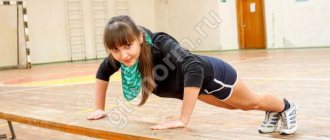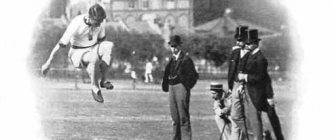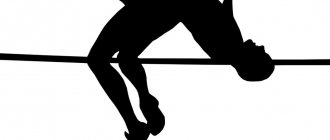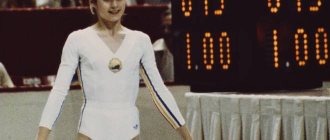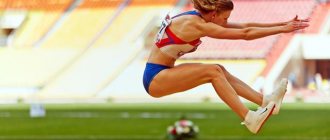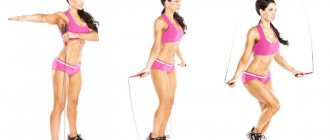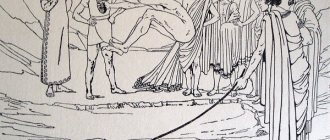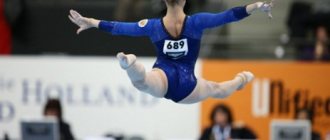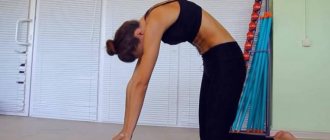Jumping is a natural movement for humans, and sometimes it is necessary for salvation in an emergency situation. Apart from everyday life, long jump is a very popular sport. In the school curriculum, the main emphasis is placed on them, so that students know how to properly perform the standing long jump and can perform the exercise even in a stressful situation. This skill is easy to learn, but can take weeks or months of practice to achieve good results.
Standards for standing jump
The first serious encounter with jumping occurs at school during physical education lessons. First, the teacher teaches the technique of standing long jump, and at the end of the year you need to pass the standards.
Every year they become stricter and stricter, taking into account the age of the growing child. Examples of standards can be seen in the table below.
The student makes three attempts and the best result is graded.
An attempt is not counted if the athlete violates one of the rules:
- You must not step beyond the take-off line or touch it.
- You cannot push off with your legs one by one - only with both legs together.
- You cannot use additional weights thrown forward during a jump.
- You cannot pre-jump before pushing off from the ground.
If we are talking about adult athletes, then the standards for them differ depending on age. Look at the data in the table, where B is bronze, C is silver, Z is gold.
Compliance rules and violations are no different from school standards.
Features of performing a jump by children 4–5 years old
Children aged 4-5 years do not yet have an understanding of the interdependence of motor actions; many children begin the jump almost on the fly, without fixing the starting position, bend their legs excessively or insufficiently in the preparatory phase; Often there is a dense placement of the feet or their parallel arrangement, the abduction of the arms far back and up; Children do not always achieve energetic repulsion, since the development of repulsion force occurs at an older age; lack of coordination of movements.
Positive trends in jumping skills:
- children jump from a height of 20 cm. When landing, they bend their legs arbitrarily and maintain stable balance;
- The standing long jump in children of the fifth year of life has a more clear structure, but its performance is characterized by a number of features.
Exercises to develop jumping skills
In the middle group, only simple jumps are still retained: jumps, jumps and standing long jumps.
Bouncing is complicated by various tasks:
- jumps with a turn to the left, right, around;
- jumping in the position of legs together, legs apart;
- jumping on two legs while moving forward, etc.
The technique of hopping on one leg is introduced: everyone hops on one leg as much as they can.
To clarify the jumping technique, the following exercises are used:
- straighten up from a half-squat, rise on your toes - to practice the correct starting position in the preparatory phase of the jump;
- rise on your toes with a forward swing of your arms - the ability to combine a forward-upward swing of your arms with push-off;
- jumping over an obstacle (flat hoop, cube) - to master the optimal jump trajectory;
By the end of the year, you can introduce jumps for results (as far as possible) into the lesson.
Jumping techniques are improved in games. For example, the game "Birds and Cat" uses jumping, etc.
Guidelines for teaching jumping techniques
When showing and explaining the movements, the teacher draws the children's attention to some elements of jumping, for example, the correct starting position in jumping. The most common shortcomings of the initial pose are tight placement of the feet or their non-parallel position, toes turned outward, as well as squatting too deeply and moving the arms far back and up. At the 5th year, almost all children push off with both legs at the same time. A wave of hands also appears. However, there is still no complete consistency in the swing, moving the arms forward and pushing off. It shouldn't be sought after. Children at this age are taught only to swing their arms forward and up during repulsion. Pay attention to a strong push and a sharp wave of the arms.
The teacher needs to pay attention to the depth of the squat when landing - it should not be deep. When jumping, you need to make sure that children jump down and only slightly forward. Before jumping, bend your legs slightly. While jumping, the teacher reminds the children that they should keep their torso straight, look forward, and not bend over when landing. Monitor children's breathing: children should breathe evenly and rhythmically.
Standing long jump technique
At first glance, the exercise looks very simple: the legs come off the surface at the same time, a jump is performed, and after contact with the ground, the jumper must straighten up and leave the landing zone. But there are so many nuances here, on which the result depends, that there is enough information for an entire article.
The goal of this exercise is to cover the maximum distance. Measurements are taken from the jump line to the landing point. The landing point is considered to be the closest place touched by the jumper with any part of the body.
The distance is measured from the jump line to the point of closest contact with the ground.
For example, if the legs are at the 200 cm mark, but the athlete rests his palm at the 180 cm mark, exactly 180 cm will be counted.
Athletes spend a long time practicing their technique in order to learn how to jump far: both 2.5 and 3 meters in length.
Preparing for the jump
The workout always begins with a thorough warm-up of the whole body, and especially the leg muscles. Without warming up, you can damage your joints or ligaments while jumping.
You can warm up with simple stretching exercises. Do a few squats, raises on your toes, and rotate your legs in and out. Only after this can you proceed directly to jumping.
The starting position plays a huge role in the final result of the jump. The force of the push, the height and length of the flight depend on it.
Take the correct position next to the starting line:
- Feet shoulder-width apart, resting on the entire foot.
- Bend your arms slightly at the elbows, lower them down and move them back.
- Bend your hips and knees so that they are level with your toes.
- The body is slightly tilted forward.
Make sure your toes don't touch the starting line.
Pushing off the ground
You need to push off with both legs at once - the push should be strong and sharp. In this case, an energetic wave of the arms is performed in the direction of the jump. Your whole body should be like a spring.
Your body weight should be directed forward, leaning 45 degrees, as if you were falling forward. Thanks to this and the coordinated movements of your arms and legs, you will direct the force of the jump not upward, but forward.
Direct the jump not up, but forward.
Now let's look at each movement separately:
- Hands are rarely thrown forward in the direction of the jump.
- The hip joints are pulled forward and upward.
- The knees straighten sharply, giving impulse to the whole body.
- The feet come off the ground with force, pushing off from it with the toes.
It is at this stage that the full potential of the jump is formed. It is important to have strong and powerful legs to cover the maximum distance.
Flying in the air
Having taken off from the ground, the athlete moves forward in free flight in the direction of the jump. It is important at this moment not to create additional obstacles and to group.
To do this, the legs are tucked as close to the body as possible, and the feet are brought forward as much as possible. This will allow you to place them further from the starting line, but here you need to maintain a balance - you cannot fall at the end, so as not to spoil the result.
It is important to coordinate the movements of your arms and legs.
Hands also take an active part - they need to be brought forward, and as if stretched as far as possible from the starting line.
Professional athletes bring their arms and legs forward so that they form parallel lines. In this position, the body takes up minimal space and air resistance decreases.
Landing
Before landing, you need to lower your arms down and take your feet as far as possible. If the knees were bent, at this moment they are straightened so that contact with the ground occurs at the maximum distance from the starting line.
You cannot land on straight legs - you can damage your knees. They must be half-bent. You need to land on both feet at once. The center of gravity is transferred to the heels - try to stand on them or on the entire foot.
The most important task is not to fall back.
Now each movement is more detailed:
- The feet are brought forward so that they are the first to touch the ground, at the maximum distance from the starting line.
- Once in contact with the ground, the arms are brought forward to maintain balance.
- The knees bend more, providing an elastic landing - this will reduce the stress on the ligaments and joints.
- The athlete takes a stable position, then straightens up and leaves the exercise area.
During landing, precise coordination of movements is required so that falling back does not spoil the result.
Effective exercises
To quickly learn how to jump high in volleyball, only the most effective exercises should be used in training.
Jumping rope
Jumping rope is a fairly popular exercise in many sports disciplines. Such a training tool allows you to develop your calf and soleus muscles with great efficiency.
It is recommended to train with a jump rope from 15 to 20 minutes a day, gradually the time should be increased to 30 minutes. The first improvements will be visible within 14-28 days. In order to increase the height of your high jump in the near future, you should push off as hard as possible from the surface with both feet, while keeping your ankles as close to each other as possible.
Squats
Doing squats with weights allows you to develop your leg muscles, as well as your lower back and abdominal muscles. It will also contribute to the implementation of the athlete’s plans aimed at increasing the jump height.
For basketball players, gymnasts and volleyball players, push squats can help answer the question of increasing their vertical jump. To do this, you will need to squat down to a parallel line with the floor and try to jump out of this position using force. It is important to ensure that the landing time is as short as possible. A large amplitude of squats can involve all groups of legs. You need to perform this technique 15 squats with a break of 3-4 minutes between approaches.
Raise on toes
These calf raises will help strengthen your calf muscles. It should be done until the calves are completely burned. During the technique, 20 to 30 repetitions of the full amplitude should be used. The athlete should stand almost on his toes, and then smoothly lower himself onto his heels. The technique itself is performed without jerking, and as endurance increases, you will need to add weights.
Frog
This technique should be performed in 4 sets of 15 jumps:
- Take the starting position, for which place your feet shoulder-width apart and bend slightly at the knee joint.
- Next, perform the lowest possible squat.
- From this position, perform the longest possible jump in terms of range.
Burnout
Burning out - the exercise is performed like this:
- Take a half-squat position.
- Rise up on your toes.
- Make a jump without changing your previously made pose.
The main emphasis when performing this technique should be on speed. It is recommended to do 5 sets of 10 times.
Ball wall
Execution steps:
- You will need to take a ball, which will need to be placed between your back and the wall.
- Having secured yourself in this position, do a squat so that the legs of the person performing the exercise are bent at the knees at a right angle.
- Make sure your thighs are parallel to the floor.
- You need to stay in the position with the ball behind your back for 10 minutes.
In total, no more than 5 approaches should be done.
Other
The following will also help you develop your jump height:
- High jump on one leg. To perform this exercise, you should stand on one leg, which is the starting position, and jump up as high as possible. The leg that is in a free position must be pressed to the chest and perform 5 sets of 10 jumps on each leg.
- Acceleration. This exercise is based on accelerated running with rest breaks. The duration of the race should be no more than 30 seconds and no less than 20. You should perform 10 accelerations per 50 meters or 15 accelerations per 30 meters.
- Step-ups. First of all, you will need to place your foot on an elevation, and then push off with your supporting leg upward. In the air you need to switch your legs. This should be done in 3 approaches with a break of 5 minutes.
How to perform a standing triple jump
The standing triple jump is one of the varieties of standing jumps. It is included in the athletics competition program.
If a technique consists of more elements than a simple jump:
- Push off with both feet.
- Push off with one leg.
- Push off with your other foot.
- Land on two feet.
When performing a triple jump, you need to alternate legs and land on both feet at the end.
- The first take-off, performed with both legs, is no different from a regular standing long jump.
- But instead of landing, you need to throw your leg forward, bending it at the knee. The shin is directed downwards and slightly forward. The second leg is also slightly bent at the knee and goes slightly behind.
- When landing on your first leg, you need to use the so-called “raking” movement, and at the same time, bring your back leg forward with a sharp swing. The front leg performs a powerful push-off, directing the body forward.
- After this, the movements are performed in the same way, but the leading and hind legs change.
- During the last flight before the final landing, you need to pull the take-off leg towards the fly leg. They are both bent, bringing them as close as possible to the chest. During landing, the classic technique of regular standing jumps is used.
To get the best results, you need to push off with maximum force, try to increase the flight phase and do not rush to lower the fly leg during take-off.
Description of the jump
Jumping high is extremely important in certain sports disciplines, for example, in volleyball and basketball, the outcome of the competition will depend on this skill. When performing it, muscle groups throughout the body are involved.
Muscle groups
To understand how to increase your high jump, you need to understand which muscles are involved. These primarily include the calf muscles and quadriceps, and the jump itself is based on the force of the jerk.
The largest muscle group, which is called the front part of the thigh, is responsible for pushing the body out of place by extending the legs. The calf muscle also plays a significant role in the jump. The pushing movements depend on the following sequence: ankle, lower leg and thigh. First of all, due attention should be paid to this muscle group and ligaments in order to achieve the desired result.
Necessary conditions, principles of training
Training with exercises to increase the height jump is not only aimed at efficiency, there must be time for recovery. The most optimal number of sessions for development should not exceed 4 times every 7 days. This in turn will prevent overtraining, muscle tension and wear.
To achieve significant results, you should systematically do the necessary exercises, avoiding omissions. In athletics, there are several types of standing high jumps, and despite the fact that they differ from each other in execution technique, they are the same in result.
The training program is based on the following principles:
- Speed exercises. To perform these exercises correctly, the athlete needs to take such a weight with which he could perform the exercise no more than seven times in one approach. The first part of the movement is performed at maximum speed, which is called explosive force. Returning to the starting position is done slowly. When performing approaches, there should be no more than two in total. Such training should be performed no more than once every 7 days.
- Exercises based on the principle of progressive rest. The athlete, as in the first training session, should select the optimal weight. Perform 3 repetitions of the training course, then rest for 15 seconds and again take on the same number of repetitions, but with a slight adjustment to increase the rest by another 15 seconds. A total of 4 approaches are required.
- Exercises based on the principle of progressive load. After each workout, you should increase the weight.
Exercises to increase jump length
To achieve good results, you need not only to master the correct standing jumping technique, but also to have physical characteristics. The main emphasis is on the legs - the length of the jump depends on their strength and flexibility. But the abdominal, chest and arm muscles are also important for performing the exercise.
Below are exercises that will help strengthen the body and develop the necessary muscles.
The complex is designed for experienced athletes, so beginner athletes first need:
- strengthen joints and ligaments;
- work on stretching and flexibility of the body;
- become familiar with the correct jumping technique;
- carefully control the load, adjusting it to your abilities.
You won’t become an athlete overnight, so don’t rush. Monitor your condition and stop training if you feel unwell. Start with a minimum load, gradually increasing it, focusing on your feelings.
The duration of the exercise complex is 2-4 weeks. Train 2-3 times a week. Perform each exercise 3 series per day, the duration of the break between series is at your discretion.
Squats and jumping to heights
- Start with squats - 10 times. Use your weight first, then add +10-20% additional weight.
- Proceed to the half-squat jumping exercise – 10 times. At first it’s simple, then pick up weights (from 10 kg to 50% of your weight).
- Finish the superset with the exercise “jumping on a pedestal” – 10 times. Start with a cabinet 40 cm high, and gradually increase it to 50% of your height.
Jumping from depth and over barriers
Perform a deep hurdle jump 10 times. The initial distance is about 1.5 meters between barriers. Increase each time. Height from 40 cm, and gradually increase.
Jumping with weights
And, of course, constantly practice jumping:
- jumping forward – 3 times;
- jumping while standing still, raising your knees as much as possible – 3 times.
Practice doing it without load, and then do it with additional weight. Over time, raise the weight to 60% of your bodyweight.
Typical execution errors
It is very easy to make mistakes during the exercise. Moreover, they are found in both schoolchildren and athletes.
Making mistakes is not scary, but not correcting them is scary.
If after a long period of training you are unable to do anything, try to find the mistake in your technique. The most common mistakes are presented below.
- Not warming up before training is very important for your safety. A few minutes can save your ligaments and knees from injury.
- The movements of the arms and legs are inconsistent with each other. Stand in front of a mirror and try to perform the movements while standing still.
- When landing, your legs drop earlier than they should. The reason may lie in weak abdominal or back muscles.
- The knees do not fully extend when taking off, which reduces the force of the jump. This happens when you are in a hurry.
- The body stands straight rather than pushed forward, which is why the jump is directed in height rather than in length.
- When landing, the jumper falls and falls backwards. You need to learn to group yourself in the air, straighten your legs towards the ground early and, after landing, throw your arms forward to maintain balance.
- Poor general physical fitness of the athlete - weak legs, lack of flexibility, problems with controlling his own body.
Ask someone knowledgeable to evaluate your technique from the outside to suggest your mistakes. If you have no one to turn to, record the training on video and watch it at home with an open mind.
Do stretching exercises, jog and do more knee lifts. Work your upper body muscles. Watch recordings of the performances of professional athletes, as you can only learn from the best how to jump far from a standing position.

